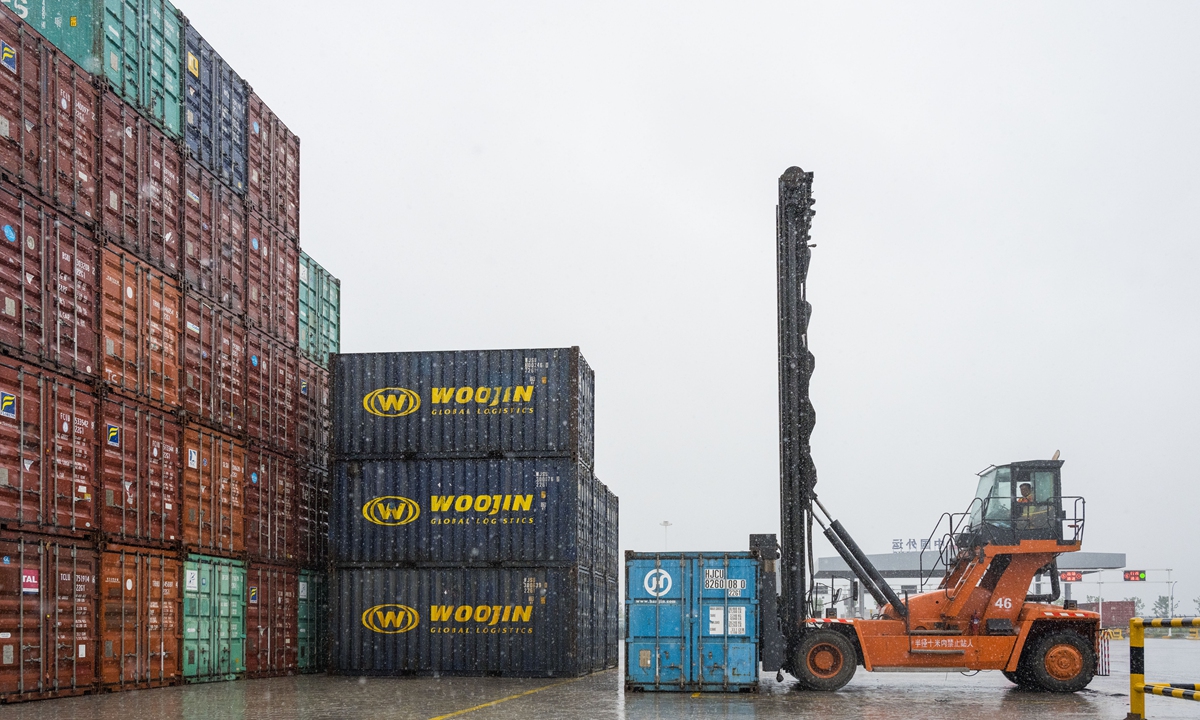
A view of the Shanghai Cooperation Organization (SCO) International Logistics Park in Lianyungang, East China's Jiangsu Province. Photo: Chen Tao/GT
On a recent raining day, workers at the SCO (Lianyungang) International Logistics Park in Lianyungang, a vibrant seaside city in East China's Jiangsu Province, busy themselves atop a striking red and yellow train.
Behind the hive of activity is a lengthy procession of 40 vehicles carrying auto parts, electronic products, and daily necessities from factories in nearby cities, standing ready for a cross-border journey to Kyrgyzstan, and ultimately, Uzbekistan.
The route, launched in October 2022, was specially designed to satisfy surging export demand in the two Central Asian countries, and serves as an additional service for the China-Europe rail in the city.
Train operations reflect the booming trade and economic connectivity among the member countries of SCO (Shanghai Cooperation Organisation) under China-proposed Belt and Road Initiative (BRI). This also marks a milestone for the park, which serves as a logistics hub for the landlocked Central Asian nations.
Born out of demandConstructed in April 2015, the SCO (Lianyungang) International Logistics Park, now covering an area of 69.79 square kilometers and home to more than 1,600 enterprises, was designed to provide logistics and overseas warehousing services for SCO members.
In the course of eight years, the logistics park, with a multimodal logistics system, integrating roads, railways, rivers, and the sea, has become a key land-sea transfer hub for SCO members to conduct trade with countries such as South Korea, Japan, and Vietnam, Yang Yan, one of the people in charge of the SCO (Lianyungang) International Logistics Park, told the Global Times during an interview at the park.
The park's expansion has been aided by China's trade with SCO members, currently consisting of eight member states including China, India, Kazakhstan, Kyrgyzstan, Russia, Pakistan, Tajikistan, and Uzbekistan.
In 2021, the trade volume between China and other SCO member states reached $343.3 billion, a year-on-year increase of 40 percent, which is 28 times that of when the SCO was established in 2001, according to data from China's Commerce Ministry.
Prompted by huge demands, the park opened the first China- Kyrgyzstan -Uzbekistan route on October 13, 2022, embarking on a journey of bridging China's trade with other SCO members through its geopolitical advantage.
"Our train services primarily focus on export businesses in Lianyungang, as well as the surrounding regions of Shandong Province, Shanghai, and Zhejiang Province. Additionally, we have significantly reduced wait time at the port, and employ a 'ready-to-go' approach, where the train departs as soon as it arrives," Yang said.
Yang elaborated that the newly opened route is particularly welcomed by exporters. Since the first China-Kyrgyzstan-Uzbekistan route of the park launched, approximately eight months ago, a total of 411 freight cars had been sent abroad via the park as of June.
These freight cars have so far transported a total of 822 twenty-foot-equivalent unit (TEUs) of products ranging from new-energy vehicles, small household appliances, maternal and infant products, daily necessities, and some small household appliances, estimated at $13.39 million, according to information provided by the SCO (Lianyungang) International Logistics Park.
More routes on the way
Under the BRI mechanism, Lianyungang city has established six major logistics channels that link Lianyungang with five Central Asian countries, Mongolia, Kyrgyzstan-Uzbekistan, Russia, Turkey (across the Caspian Sea), and Germany, according to information provided by Lianyungang New Silk Road International Container Development Co.
Nevertheless, for many Chinese exporters, the additional services can barely cover surging export demand.
"During the busy season, our products might have to wait two months before being transported to our customers. We hope there will be an increased frequency of services every month," Zhang Bin, a manager at Guanghui Auto Parts Co in Nantong, a city about 360 kilometers from Lianyungang, told the Global Times.
Compared with the 2019 figures, Zhang said, the company is witnessing a roughly 30 percent increase in orders from Central Asian countries like Kazakhstan, and sometimes the company has to pay additional fees to cargo agents, to have time-sensitive orders delivered quickly.
"We are in the process of expanding our train services with a new layout. Our focus is not only on maintaining regular and frequent shipments on the China-Kazakhstan-Uzbekistan train route, but also increasing the frequency. Our goal is to achieve six departures per month on this route," Yang said.
On June 13, the Lianyungang Port Holdings Group and Uzbekistan Railways Container Company officially signed a memorandum of cooperation. The two parties initiated preliminary discussions on the design of a new route from Lianyungang to Uzbekistan, while expressing eagerness at the prospect of future collaboration in the SCO International Logistics Park in Lianyungang, according to a statement the Lianyungang port sent to the Global Times.
According to the memorandum, the two parties will also study the feasibility of jointly investing in the construction of warehouses in both Uzbekistan and Lianyungang, which will serve as bonded storage and distribution centers for goods.
The park is also seeking to extend a route to Russia. "We have considered putting together a consignment of goods from China's central and western regions at the Lianyungang port to be shipped and transported to Vladivostok via rail and sea," Yang said.
In another effort to further deepening trade connection and interconnectivity among SCO countries, the third China-SCO International Logistics Roundtable Conference, which is expected to invite high-level international officials, is also scheduled to be held in Lianyungang in August, according to information the Global Times obtained.
"The SCO logistics park's cross-border rail plus overseas warehouse model will provide strong support for production capacity cooperation and economic and trade exchanges among SCO countries, and further streamline the land-sea transport channel of the New Eurasian Continental Bridge," Yang said.




